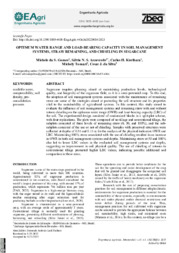Optimum water range and load-bearing capacity in soil management systems, straw remaining, and chiseling in sugarcane.
Optimum water range and load-bearing capacity in soil management systems, straw remaining, and chiseling in sugarcane.
Author(s): GOMES, M. da S.; ARCOVERDE, S. N. S.; KURIHARA, C. H.; TOMAZI, M.; SILVA, C. J. da
Summary: Sugarcane requires planning aimed at maintaining production levels, technological quality, and longevity of the sugarcane field, as it is a semi-perennial crop. To this end, the adoption of soil management systems associated with the maintenance of remaining straw are some of the strategies aimed at protecting the soil structure and its properties vital to the sustainability of agricultural systems. In this context, this study aimed to evaluate the influence of soil management systems and remaining straw with and without ratoon chiseling on the optimum water range (OWR) and load-bearing capacity (LBC) of the soil. The experimental design consisted of randomized blocks in a split-plot scheme, with four replications. The plots were composed of no-tillage and conventional tillage, the subplots consisted of three levels of remaining straw (0, 50, and 100%), and the sub- subplots consisted of the use or not of chiseling. Samples with preserved structures were collected at depths of 0.05 and 0.15 m for the analysis of the physical indicators OWR and LBC. Maintaining 100% straw associated with the use of chiseling resulted in an increase in OWR in both soil management systems and depths. Maintaining straw at 50 and 100% also led to lower LBC values in the evaluated soil management systems and depths, suggesting an improvement in soil physical quality. The use of chiseling of ratoons in conventional tillage promoted higher LBC values, indicating possible additional soil compaction in these areas.
Publication year: 2023
Types of publication: Journal article
Keywords: Cana de Açúcar, Manejo do Solo, Água
Observation
Some of Embrapa's publications are published as ePub files. To read them, use or download one of the following free software options to your computer or mobile device. Android: Google Play Books; IOS: iBooks; Windows and Linux: Calibre.
Access other publications
Access the Agricultural Research Database (BDPA) to consult Embrapa's full library collection and records.
Visit Embrapa Bookstore to purchase books and other publications sold by Embrapa.

